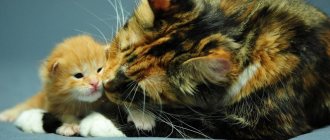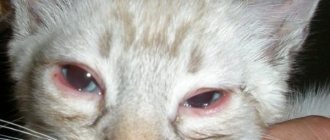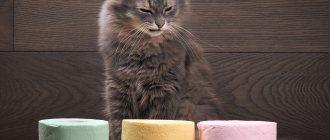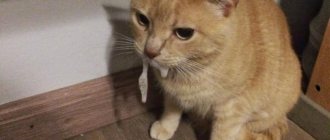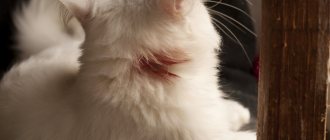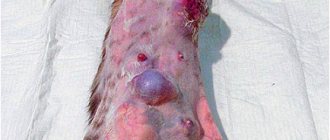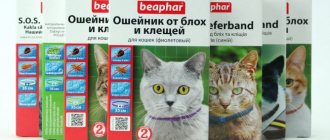What is an umbilical hernia
A hernia is the partial prolapse of internal organs under the skin through openings formed naturally or due to injury. The umbilical differs in that it is recognized in the navel area. In this case, a loop of intestine sticks out. The umbilical ring is poorly formed, which makes the formation noticeable and palpable.
Umbilical hernia in a kitten
How dangerous is an umbilical hernia for a cat?
In itself, displacement and protrusion of internal organs is not a life-threatening condition for the animal. However, even non-strangulated hernias provoke disruption of the normal functioning of internal organs.
However, all hernia pathologies without exception are fraught with strangulation. This phenomenon occurs when it is impossible to reduce the contents of the hernial sac.
a) Palpation of the hernial contents with the cat in the supine position; b) Digital reduction of the umbilical hernia.
Irreversible pathology leads to impaired blood supply to strangulated organs and tissue necrosis. Rapid inflammation of the surrounding tissues occurs, and the animal experiences severe pain.
When vital organs (bladder, intestines, uterus) are infringed due to necrosis, general intoxication of the body occurs. Necrotic phenomena in advanced cases cause the death of a pet from developing sepsis. The death of an animal can occur due to severe painful shock.
If the protrusion in the navel or abdomen cannot be reduced, is hard, painful, there is fever, vomiting and refusal to feed, the pet should be immediately taken to a veterinary facility.
Why is an umbilical hernia dangerous for kittens?
Hernias on a kitten's stomach often do not cause the animal much discomfort. However, as your pet grows, its internal organs will begin to enlarge. As a result of this, the umbilical ring, which does not change its previous size, begins to put pressure on the prolapsed part of the organ. This leads to painful sensations in the abdominal cavity. The cat begins to behave restlessly, her temperature increases, and her appetite disappears. Sometimes the animal vomits.
Vomiting in a kitten: why and what to do about nausea
In addition to the pet’s poor health, the danger of a hernia lies in the disruption of blood circulation in the compressed part of the intestine. This leads to irreversible changes in intestinal tissue. Without proper treatment, your pet begins to experience tissue necrosis.
Reference! Necrosis progresses rapidly, leading to intoxication of the entire body. The result is shock and sepsis.
The described dangers lead to the death of the pet.
How to recognize the symptoms?
A deviation from the norm that the pet owner should pay attention to is the prolonged healing of the navel after birth.
Every person who has a cat should know what such a deviation looks like in order to take the pet to the veterinary clinic in time. An umbilical hernia in a newborn kitten can go undetected for a long time, causing treatment to be delayed. Owners should be alarmed if their pet’s umbilical cord has not fallen off 14 days after birth, as this may be the first symptom of the progression of the pathology. In a kitten, an umbilical hernia is accompanied by a lump in the abdominal area, which may not cause pain. As the hernial protrusion increases, pain syndrome subsequently appears. Additional symptoms are observed only if other internal organs are pinched. With an umbilical hernia, the following clinical picture in a kitten is likely:
- gagging;
- the wound in the navel area bleeds and does not heal well;
- loss of appetite;
- increased body temperature;
- digestive problems;
- broken stool;
- death of tissue around the navel.
Causes of umbilical hernia
Constipation in a kitten: what to do at home
The key reason for the appearance of such a pathology is poor development of the abdominal muscles and connective tissue. As a result, the body simply cannot keep the internal organs in their proper places. In addition, there are the following reasons for the appearance of a hernia in a cat on the stomach:
- trauma at birth;
- genetic predisposition;
- strong pressure from the inside on the abdominal muscles. Occurs as a result of regular constipation, diarrhea, and vomiting. In all of these processes, a strong contraction of the diaphragmatic region, stomach and abdomen is observed.
Hernias may appear after a cat is sterilized. The cause may be errors in caring for the animal, poor-quality surgery, the advanced age of the pet, or the effects of anesthesia.
Veterinarian examination
What to do and how to treat the deviation?
Conservative treatment
It is possible to remove hernial protrusion in small individuals at an early stage using conservative methods. For this purpose, the pet is prescribed medications and ointments with an irritating effect. A cat's hernia on her stomach will go away faster if you regularly massage the hernial ring. After manual reduction of the formation, it is necessary to use a special patch that provides fixation. If the pericardial hernia is small, it can heal on its own in the kitten by 6 months after birth.
When is surgery required?
Basically, this pathology is eliminated by performing a herniotomy on the animal.
As a rule, conservative therapy for pathological disorders in young felines is ineffective. It is important to understand that in advanced cases, removing a tumor in the navel area is possible only through surgical intervention. Such surgery is known in veterinary medicine as herniotomy, during which the hernial sac is removed using a scalpel. This technique gives the most positive results and is performed under general anesthesia. It is not recommended to remove a hernia in the abdominal area using local anesthesia, since the kitten may feel pain. The operation is performed in a veterinary clinic, and complications occur in rare cases. Surgical intervention for umbilical hernia is performed in the following sequence:
- The surgeon uses a scalpel to excise the skin above the umbilical ring. A small hernial protrusion requires a straight incision, while a large neoplasm requires a spindle-shaped incision.
- The peritoneal tissue is peeled off and the internal organs are inserted into the abdominal cavity.
- The lumen is reduced, then sutures are placed.
Surgery to remove a hernia is performed on male cats after they reach one month of age. Females can have the tumor removed at six months. If there is a threat of necrosis of vital organs, then radical treatment may be performed earlier.
Classification of species
Umbilical hernia varies in severity and can be reducible or irreducible. The first type is characterized by the absence of pain and easily returns to the peritoneum with slight pressure. If the kitten is turned onto its back, such a hernia will retract on its own, and the belly will become flat.
Diarrhea in a kitten: what to do and how to treat it at home
An irreducible tubercle causes pain and discomfort. The formation is hot, if touched, almost motionless. Due to the inflammatory process inside, it may gradually increase in size.
Reference! A reducible hernia can develop into a second type of hernia due to the onset of inflammation inside the formation. Additionally, adhesions and pinching may form.
Is it possible to help an animal yourself?
Sometimes owners try to treat an umbilical hernia in a kitten at home. This is not recommended. Most often, owners repair the hernia by turning the pet on its back. They trim the fur around the ring where the organs have fallen out and massage it. Afterwards, the hernia is repaired and a coin or button is applied to it, which is secured with an adhesive plaster. The bandage is changed periodically and they wait for the moment when the ring into which the organs fall out heals. But most often this does not happen.
By repairing the hernia themselves, owners put the kitten's life at risk. If you do something wrong, the likelihood of infringement will increase. Sometimes, without seeing any results, owners begin to warm up the area of the hernial sac. These actions will only worsen the pet's situation. In some cases, after warming up, the baby dies.
Diagnosis of the disease
Diagnosis is carried out using an external examination. The hernia is always visible; it looks like a new growth in the navel area. It is also necessary to determine the type of disease. A reducible hernia is movable when pressed and may disappear when the pet changes body position. The cat feels good due to the absence of pain.
The irreducible one has a convex shape that increases in size over time. It is hot to the touch and causes a lot of discomfort in the animal.
Care after hernia removal
Treatment of umbilical hernia in a cat
After diagnosing and making an accurate diagnosis, it is necessary to begin treating a hernia in the cat’s stomach.
Important! It is forbidden to try to treat an animal yourself, without consulting a doctor. You cannot carry out thermal procedures or try to straighten protruding organs with your own hands.
Conservative methods
Conservative therapy involves the use of ointment, the use of a special therapeutic massage of the affected area and the application of a plaster to fix the area after reduction.
In a kitten, with good treatment, the hernia can close by 6 months. In other cases, for older individuals, conservative treatment is not enough.
Folk remedies
The most effective folk method is to straighten the affected area and fix it with a plaster. Additionally, use a flat, dense object, such as a coin or button, to make the fixation more reliable. In a young pet, with a small hernia, it heals.
Prevention
Even with unfavorable heredity, the development of an umbilical hernia can be avoided. Moreover, with proper care, even a small hernia that has formed can sometimes heal spontaneously.
First of all, immediately after the babies are born, they should be shown to a veterinarian, who will assess the risk of developing pathology and, possibly, prescribe a tummy massage and fixation of the umbilical cord with a bandage. Often these actions are quite enough.
Later, when the children’s lifestyle becomes more active, you need to carefully monitor that the abdominal wall is not overstrained: pay special attention to the diet to avoid possible constipation or diarrhea.
Surgery
Surgical excision is the most radical way to eliminate the formation. General and local anesthesia is used for the operation. The veterinarian chooses the appropriate option after examining the pet.
The essence of the operation is to cut the skin. If the hernia is small, the incision is made straight. For large formations, a spindle-shaped one is used. When the tissues are peeled off, the doctor moves the organs to the peritoneal area, where they should be.
Then the lumen of the ring near the navel is reduced and sutures begin.
For cats, surgery can be performed at the age of 1 month or later, and for cats no earlier than six months. In serious cases, it is permissible to have surgery earlier.
Prevention of hernia in kittens
Prevention of hernia in kittens
The appearance of various types of hernias in kittens is due to two main reasons:
- Heredity. It is typical for purebred cats that have similar cases in their pedigree. This is the most common cause of umbilical hernia in a kitten.
- Innateness. It can manifest itself in cases of embryogenesis disturbances and adverse effects on the mother’s body during pregnancy.
- Traumatic injuries. Associated with birth trauma, for example, improper gnawing of the umbilical cord: the cat inaccurately pulled it and tore it or chewed it early. The muscle ring is injured and the tightening is disrupted. The damage may be minor and not visually detectable, in which case it is detected only by palpation. Constipation, gas and vomiting can cause the umbilical ring to expand and the internal organs to fall outside the muscular frame.
Like the human embryo, the body of the fetus in cats is connected to the mother's body by the umbilical cord, through which it receives nutrition. After birth, the umbilical cord connecting mother and baby is cut or chewed, and the umbilical ring, open during fetal development, is closed.
The remnants of the umbilical cord dry out within a few days, after which there are no traces of its presence on the kitten’s stomach. But this happens normally.
But if, during the first four weeks after the birth of the baby, a bulge - a hernia - forms at the site of the umbilical ring, the cause of the developmental anomaly may be:
- genetic predisposition;
- increased pressure inside the peritoneum;
- binge eating;
- disorders in the gastrointestinal tract (flatulence, indigestion);
- traumatic influence from the outside.
It is important to understand that all these factors only contribute to the strengthening of the main symptoms - weakening of the tone of the umbilical ring. This is the main cause of hernia.
Moreover, the pathology can be expressed stronger or weaker - which is why it is often possible to diagnose the disease even when the internal organs are strongly protruding through the peritoneal wall.
Prevention of inguinal hernia in cats
The main preventive measures include:
- balanced diet. This will eliminate constipation and improve bowel function;
- When a kitten is born, it is important to cut the umbilical cord correctly;
- exclusion of injuries. It is worth monitoring the baby’s behavior and avoiding serious falls and bruises.
It is easier to detect a formation in the umbilical area in Sphynx cats due to their characteristics, namely the lack of hair. Thanks to this, the entire abdomen is clearly visible. Pets of other breeds must be handled carefully.
If you notice signs of a hernia, you should visit a veterinarian. An important condition for a quick recovery, in addition to prescribed treatment, is competent home care. Then the pet will quickly recover.
Treatment
Treatment of a hernia in a kitten on the stomach should not be delayed under any circumstances. Due to this formation, blood circulation is impaired, which in turn negatively affects the pet’s metabolic rate.
In addition, soft tissue cells begin to die, necrosis and inflammation begin. All this can lead not only to a deterioration in the kitten’s well-being, but also to its death.
If you discover a hernia in your pet, you should immediately consult a doctor. Only a specialist will be able to accurately determine the severity of the disease and take the necessary measures to save the baby.
For small hernias, conservative treatment is acceptable. It is quite possible that the veterinarian will limit himself to applying a bandage (blanket), which will help hold the animal’s internal organs in place.
The area where the tumor is located is trimmed of hair, and the hernia is carefully pressed down. But this method also has a drawback.
It lies in the fact that the kitten will need to wear a blanket for about a month, and given the mobility and playfulness of babies, the bandage will need to be constantly checked and adjusted.
If the hernia is irreducible, immobile, or has signs of inflammation or necrosis, the doctor performs surgery. After the intervention, the kitten should wear a blanket for 8-12 days to prevent the baby from damaging the integrity of the sutures and causing an infection.
Sutures need to be treated with an antiseptic several times a day. If you notice redness, traces of discharge or swelling in the suture area, you should immediately contact your veterinarian.
Most experts agree on this opinion - the optimal solution is surgical removal of the hernia. It allows you to avoid complications and relapses of the disease.
In addition, this method of treatment is faster and more effective than the conservative one, because sutures can be removed 8-12 days after surgery.
Treatment measures depend on the severity of the process. But only a veterinary specialist should evaluate its degree—there is no place for amateur activity in this matter.
Usually, for small reducible hernias, you can get by with applying a special bandage that will help keep the organs in place. The disadvantage of this treatment is the duration of wearing the blanket (at least a month), and given the playfulness of some babies, it will have to be constantly adjusted.
